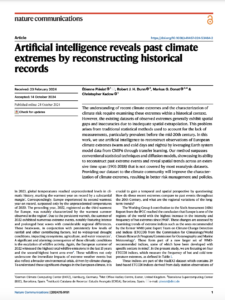Abstract
The understanding of recent climate extremes and the characterization of climate risk require examining these extremes within a historical context. However, the existing datasets of observed extremes generally exhibit spatial gaps and inaccuracies due to inadequate spatial extrapolation. This problem arises from traditional statistical methods used to account for the lack of measurements, particularly prevalent before the mid-20th century. In this work, we use artificial intelligence to reconstruct observations of European climate extremes (warm and cold days and nights) by leveraging Earth system model data from CMIP6 through transfer learning. Our method surpasses conventional statistical techniques and diffusion models, showcasing its ability to reconstruct past extreme events and reveal spatial trends across an extensive time span (1901-2018) that is not covered by most reanalysis datasets. Providing our dataset to the climate community will improve the characterization of climate extremes, resulting in better risk management and policies.
Authors
Étienne Plésiat (DKRZ), Robert J. H. Dunn (Met Office), Markus G. Donat (BSC), and Christopher Kadow (DKRZ).
